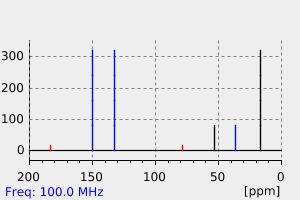4-isopropyl-4-methoxycyclohexa-2,5-dienone | 110391-95-2
中文名称
——
中文别名
——
英文名称
4-isopropyl-4-methoxycyclohexa-2,5-dienone
英文别名
4-isopropyl-4-methoxy-2,5-cyclohexadienone;4-isopropyl-4-methoxycyclohexa-2,5-dien-1-one;Cnkdaezlbanakv-uhfffaoysa-;4-methoxy-4-propan-2-ylcyclohexa-2,5-dien-1-one
CAS
110391-95-2
化学式
C10H14O2
mdl
——
分子量
166.22
InChiKey
CNKDAEZLBANAKV-UHFFFAOYSA-N
BEILSTEIN
——
EINECS
——
-
物化性质
-
计算性质
-
ADMET
-
安全信息
-
SDS
-
制备方法与用途
-
上下游信息
-
文献信息
-
表征谱图
-
同类化合物
-
相关功能分类
-
相关结构分类
物化性质
-
沸点:251.4±40.0 °C(Predicted)
-
密度:0.99±0.1 g/cm3(Predicted)
计算性质
-
辛醇/水分配系数(LogP):1.7
-
重原子数:12
-
可旋转键数:2
-
环数:1.0
-
sp3杂化的碳原子比例:0.5
-
拓扑面积:26.3
-
氢给体数:0
-
氢受体数:2
反应信息
-
作为反应物:描述:4-isopropyl-4-methoxycyclohexa-2,5-dienone 在 rhenium(VII) oxide 作用下, 以 二氯甲烷 为溶剂, 以86%的产率得到2-异丙基-4-羟基苯甲醚参考文献:名称:Re 2 O 7催化的二烯酮-苯酚重排†摘要:已经描述了由Re 2 O 7催化的4,4-二取代的环己二酮的二烯酮-苯酚重排。通过使用该催化方案,可以以良好或优异的收率有效地获得多取代的苯酚。DOI:10.1039/c5ra04931h
-
作为产物:描述:8-methoxy-8-propan-2-yl-1,4-dioxaspiro[4.5]deca-6,9-diene 在 盐酸 作用下, 以89%的产率得到4-isopropyl-4-methoxycyclohexa-2,5-dienone参考文献:名称:2-(4-烷基苯氧基)乙醇衍生物的阳极氧化中的核与侧链反应性。2-羟乙基的有趣作用摘要:在恒定电流下使用氟化钾作为电解质,在甲醇中对2-(4-烷基苯氧基)乙醇衍生物进行阳极氧化,可以得到4-烷基-4-甲氧基环己-2,5-二烯酮缩醛的良好收率。DOI:10.1039/c39870000610
文献信息
-
Synthesis of Polysubstituted Bicyclo[3.3.1]nonane-3,7-diones from Cyclohexa-2,5-dienones and Dimethyl 1,3-Acetonedicarboxylate作者:Pelayo Camps、Albert González、Diego Muñoz-Torrero、Montserrat Simon、Adriana Zúñiga、Miriam A. Martins、Mercè Font-Bardia、Xavier SolansDOI:10.1016/s0040-4020(00)00680-3日期:2000.10Oxidation of polysubstituted phenols with phenyliodonium diacetate gives cyclohexa-2,5-dienones, which on reaction with dimethyl 1,3-acetonedicarboxylate afford double-Michael-addition derivatives, whose hydrolysis and decarboxylation provides polysubstituted bicyclo[3.3.1]nonane-3,7-diones. For steric and/or electronic reasons, the Michael reaction only works with 3,5-unsubstituted or 3-substituted
-
Iodobenzene and m-chloroperbenzoic acid mediated oxidative dearomatization of phenols作者:Neha Taneja、Rama Krishna PeddintiDOI:10.1016/j.tetlet.2016.07.078日期:2016.8iodobenzene, and m-CPBA as a co-oxidant has been achieved via in situ generation of PhIO2, a hypervalent iodine(V) species. The transiently generated orthobenzoquinone monoketals further underwent Diels–Alder reaction with various dienophiles to furnish densely substituted bicyclo[2.2.2]octenones in high selectivities and yields. This methodology features ready availability of reagents, cost effectiveness, safety
-
Copper‐Catalyzed Olefination of 4‐CF <sub>3</sub> ‐Substituted Cyclohexadienones Using Sulfonylmethyl Isocyanides: An Electrostatic Repulsion‐Controlled Regioselectivity Switch Strategy作者:Seungwon Lee、Mohamed Ahmed Abozeid、Hun Young Kim、Kyungsoo OhDOI:10.1002/adsc.202201333日期:2023.2.21was shown to exert a pronounced electrostatic repulsion effect to give the olefination products via a preferential [3+2] cycloaddition with the ketone moiety followed by a facile fragmentation of transient oxazoline intermediates. The current Cu(II)-catalyzed olefination of 4-CF3-substituted cyclohexadienones demonstrates the reaction dichotomy involving a CF3-controlled 1,2-addition over a Van Leusen
-
Structural and solvent/electrolyte effects on the selectivity and efficiency of the anodic oxidation of para-substituted aromatic ethers. An efficient route to quinol ether ketals and quinol ethers作者:Michael P. Capparelli、Richard E. DeSchepper、John S. SwentonDOI:10.1021/jo00231a022日期:1987.10
-
Photorearrangement of 4-alkyl-4-alkoxy-2, 5-cyclohexadienones: synthesis of 4-(alkyldimethoxymethyl)cyclopent-2-en-1-ones作者:Arthur G. TaverasDOI:10.1016/s0040-4039(00)86661-7日期:1988.1
表征谱图
-
氢谱1HNMR
-
质谱MS
-
碳谱13CNMR
-
红外IR
-
拉曼Raman
-
峰位数据
-
峰位匹配
-
表征信息
同类化合物
(反式)-4-壬烯醛
(s)-2,3-二羟基丙酸甲酯
([1-(甲氧基甲基)-1H-1,2,4-三唑-5-基](苯基)甲酮)
(Z)-4-辛烯醛
(S)-氨基甲酸酯β-D-O-葡糖醛酸
(S)-3-(((2,2-二氟-1-羟基-7-(甲基磺酰基)-2,3-二氢-1H-茚满-4-基)氧基)-5-氟苄腈
(R)-氨基甲酸酯β-D-O-葡糖醛酸
(5,5-二甲基-2-(哌啶-2-基)环己烷-1,3-二酮)
(2,5-二氟苯基)-4-哌啶基-甲酮
龙胆苦苷
龙胆二糖甲乙酮氰醇(P)
龙胆二糖丙酮氰醇(P)
龙胆三糖
龙涎酮
齐罗硅酮
齐留通beta-D-葡糖苷酸
鼠李糖
黑芥子苷单钾盐
黑海棉酸钠盐
黑木金合欢素
黑曲霉三糖
黑介子苷
黄尿酸8-O-葡糖苷
麻西那霉素II
麦迪霉素
麦芽糖脎
麦芽糖基海藻糖
麦芽糖1-磷酸酯
麦芽糖
麦芽四糖醇
麦芽四糖
麦芽十糖
麦芽六糖
麦芽五糖水合物
麦芽五糖
麦芽五糖
麦芽五糖
麦芽三糖醇
麦芽三糖
麦芽三糖
麦芽三塘水合
麦芽七糖水合物
麦芽七糖
麦法朵
麦可酚酸-酰基-Β-D-葡糖苷酸
麦利查咪
麝香酮
鹤草酚
鸢尾酚酮 3-C-beta-D-吡喃葡萄糖苷
鸡矢藤苷







